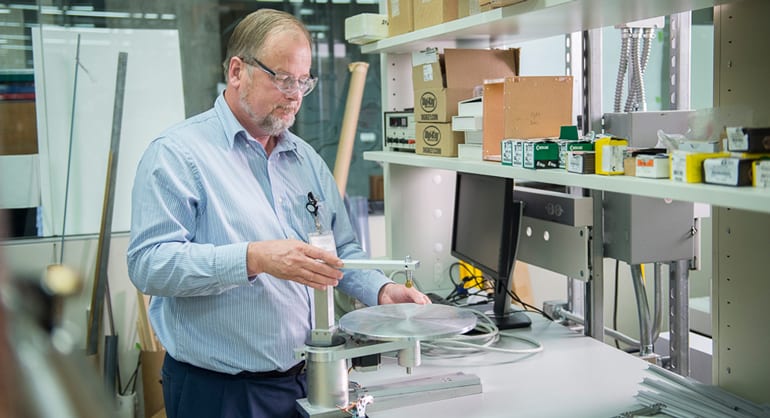The Morgridge Institute for Research has received a $20.6 million cooperative agreement from the U.S. Department of Energy’s National Nuclear Security Administration to support development of a new process and manufacturing plant for a medical isotope needed by tens of thousands of U.S. patients daily.
The cooperative agreement through the National Nuclear Security Administration’s Global Threat Reduction Initiative will support the Morgridge Institute and partner SHINE Medical Technologies in efforts to produce molybdenum-99 without weapons-usable highly enriched uranium.
Thomas “Rock” Mackie, principal investigator for the project and director of medical devices at the Morgridge Institute for Research in Madison, says the private, nonprofit research institute located on the University of Wisconsin–Madison campus will serve as the prime contractor on the project.
Mackie says the funding will support a dozen Morgridge Institute employees focusing on technical aspects of the project while SHINE Medical Technologies will serve as the primary subcontractor and use the balance to develop an $85 million plant capable of producing molybdenum-99.
“The SHINE Medical Technologies project highlights the success of our collaborative efforts to transfer technology from university labs to the private sector for the benefit of the public,” Mackie says. “Our researchers and technical experts in medical devices are working on the leading edge of discovery with SHINE Medical Technologies and other companies to make emerging technologies viable for industry use. This new, greener and safer method of producing molybdenum-99 is a good example of what lies ahead.”
SHINE Medical Technologies recently reached a decision to locate its production facilities on an 84-acre site south of Janesville across Highway 51 from the Southern Wisconsin Regional Airport. Janesville was chosen as the site after two years of analysis including an assessment of the local workforce, financial incentives and geological and geographical considerations.
“A collaborative project of this scope would not be possible without the commitment of federal funds and we are grateful for the continuing support of the Department of Energy’s National Nuclear Security Administration through this agreement with the Morgridge Institute,” says Greg Piefer, CEO of SHINE Medical Technologies. “This funding, in combination with financial and technical support from the city of Janesville, the Knox venture capital group and the Morgridge Institute, is critical as we strive to establish a safer and more reliable supply of molybdenum-99 produced without the use of highly enriched uranium. At the same time, we are excited about working with the city of Janesville, the people of Rock County and Blackhawk Technical College to create new, highly skilled job opportunities.”
Piefer said the SHINE Medical Technologies plant will create more than 150 permanent jobs with the possibility of additional employment growth. The current timetable anticipates completion of the plant and the start of production by 2015.
The $20.6 million agreement with the Morgridge Institute follows a $1 million cooperative agreement with the Department of Energy’s National Nuclear Security Administration Global Threat Reduction Initiative in September 2010. Both agreements take the form of a 50 percent/50 percent cost-share arrangement.
Progress by the Morgridge Institute and SHINE Medical Technologies on a series of technical and investment milestones supported the latest round of federal funding. The project team includes collaborators at UW–Madison, Los Alamos National Laboratory and Argonne National Laboratory. SHINE Medical Technologies previously closed on an investment in 2011 from private investors including Fred Mancheski of the Knox investment group.
The byproduct of molybdenum-99-technetium-99m-is used in 55,000 diagnostic nuclear imaging procedures each day in the U.S., including diagnoses of cardiac disease and cancer and studies of brain and kidney function.
Two nuclear reactors in Canada and the Netherlands have supplied the majority of the isotope used in this country. These reactors are operating well past their design life and in 2009 and 2010, the Canadian reactor experienced an unscheduled shutdown for 16 months due to leaks caused by corrosion. During this time the Dutch reactor was also down, virtually eliminating the conventional supply. The resulting worldwide shortage of molybdenum-99 forced hospitals to delay or cancel millions of medical procedures.
SHINE Medical Technology’s alternative method to produce the life-saving isotope combines a technology developed by UW–Madison medical physics researcher and current university Provost Paul M. DeLuca Jr. with an innovative particle acceleration process developed by Piefer. The new method offers major advantages over existing technologies because it does not use highly enriched uranium, does not require a nuclear reactor and fits well with the nation’s existing supply chain. SHINE Medical Technology’s new production method is also at least 10 times more energy efficient than other, accelerator-based approaches.
Piefer says his company is extremely grateful for the support and assistance it has received from the city of Janesville and a host of public officials in Wisconsin including U.S. Reps. Paul Ryan and Tammy Baldwin; former U.S. Sen. Russ Feingold; former Gov. Jim Doyle and Gov. Scott Walker and members of his leadership team including Paul Jadin of the Wisconsin Economic Development Corp. Community and economic development officials throughout the state also provided invaluable assistance as the startup sought information on various locations.
